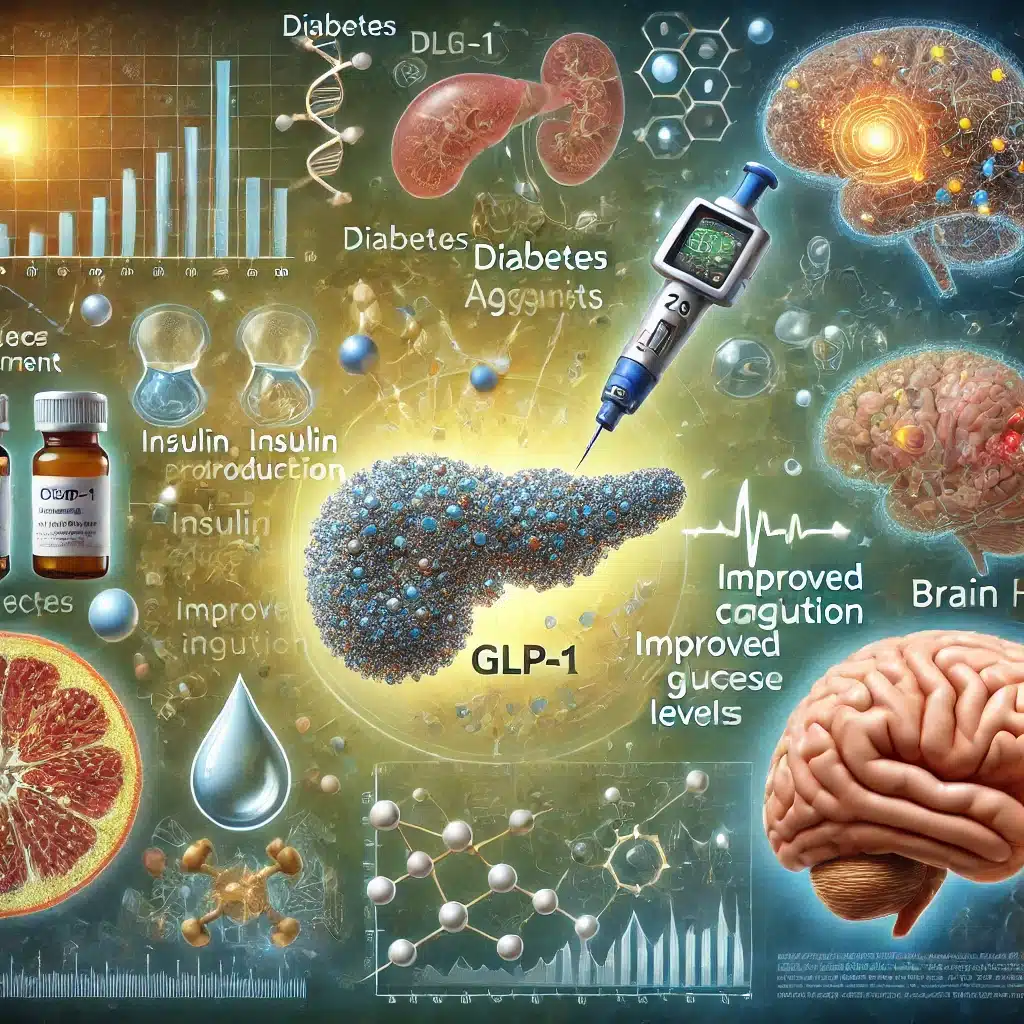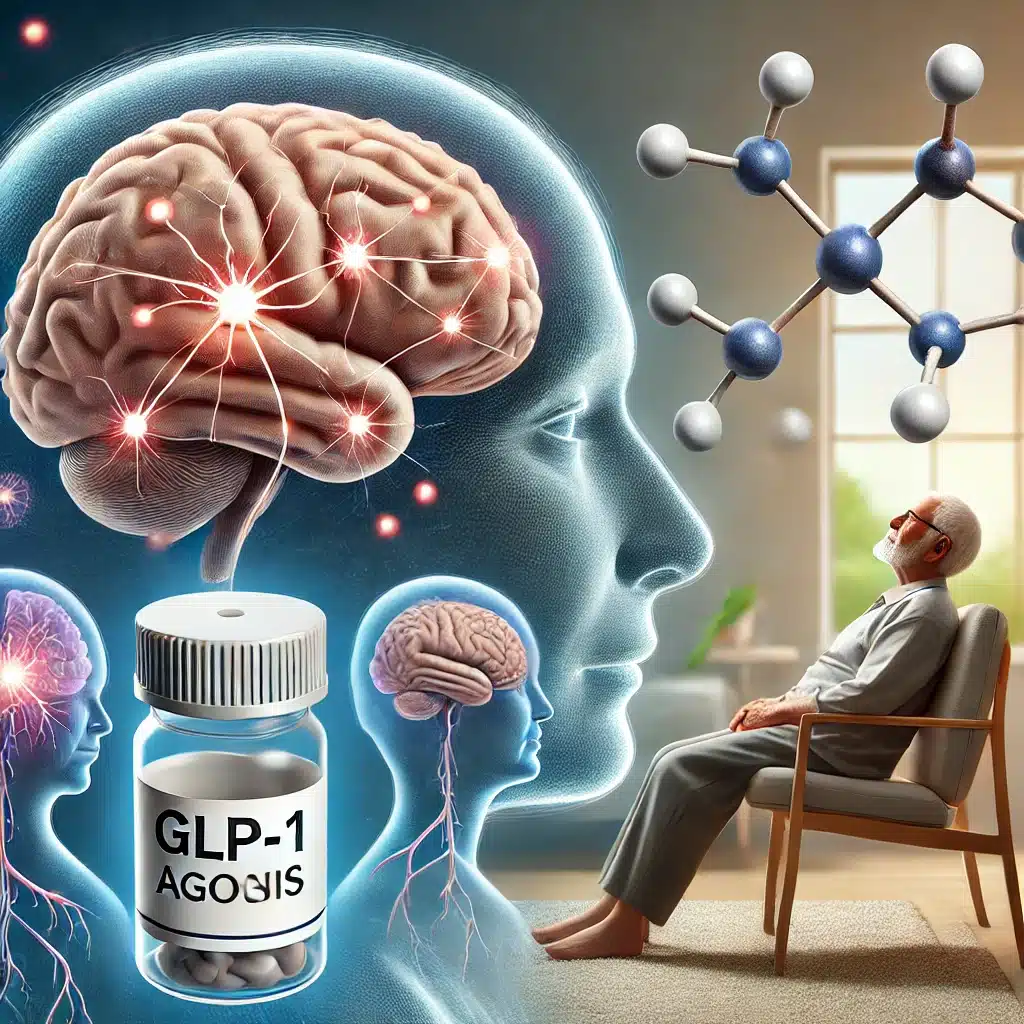TLDR: GLP-1 agonists were found to significantly reduce the risk of dementia in older individuals with type 2 diabetes mellitus (T2DM) compared to DPP-4 inhibitors and sulfonylureas.
Highlights:
- A sequential trial emulation was conducted using data from Swedish national registers from 2010 to 2020, involving 88,381 participants aged 65 or older with T2DM.
- The incidence of dementia was lower in GLP-1 agonist initiators (6.7 per 1000 person years) compared to DPP-4 inhibitors (11.8) and sulfonylureas (13.7).
- GLP-1 agonists were associated with a 31% lower risk of dementia compared to sulfonylureas and a 23% lower risk compared to DPP-4 inhibitors in the intention-to-treat analysis.
- The findings suggest that GLP-1 agonists may be more effective in reducing dementia risk in older patients with T2DM, but further clinical trials are needed to confirm these results.
Source: The Lancet (eClinical Medicine) (2024)
Link Between Type 2 Diabetes & Dementia
1. Increased Risk of Cognitive Decline
Individuals with type 2 diabetes mellitus (T2DM) have a significantly higher risk of developing dementia compared to non-diabetic individuals.
Studies have shown that people with T2DM are 1.5 to 2 times more likely to develop Alzheimer’s disease and other forms of dementia.
Cognitive decline and dementia symptoms may also appear earlier in diabetic patients than in the general population.
2. Mechanisms Contributing to Cognitive Impairment
Hyperglycemia: Chronic high blood sugar levels can damage blood vessels, including those in the brain, leading to impaired blood flow and subsequent cognitive decline.
Insulin Resistance: Insulin resistance, a hallmark of T2DM, affects not only peripheral tissues but also the brain. Insulin plays a role in neuronal signaling and cognitive functions. Insulin resistance in the brain can disrupt these processes, contributing to cognitive impairment.
Inflammation: T2DM is associated with chronic systemic inflammation, which can extend to the brain, promoting neuroinflammation. This inflammatory state is linked to the development and progression of neurodegenerative diseases, including dementia.
Oxidative Stress: Increased oxidative stress in diabetic patients can lead to neuronal damage and death. Oxidative stress is caused by an imbalance between free radicals and antioxidants in the body, which is prevalent in T2DM.
Vascular Damage: Diabetes can cause microvascular and macrovascular damage, increasing the risk of vascular dementia. Compromised blood vessels can lead to silent strokes and white matter lesions, further impairing cognitive functions.
3. Amyloid & Tau Pathology
Amyloid Plaques: T2DM may accelerate the deposition of amyloid-beta plaques in the brain, a key feature of Alzheimer’s disease. High insulin levels can compete with amyloid-beta for degradation, leading to its accumulation.
Tau Protein: Hyperinsulinemia and insulin resistance can also promote tau hyperphosphorylation, contributing to neurofibrillary tangle formation and neuronal damage.
4. Shared Risk Factors
Obesity: Obesity, often linked to T2DM, is a known risk factor for dementia. Excess body weight contributes to inflammation, insulin resistance, and vascular problems, all of which can affect cognitive health.
Hypertension & Dyslipidemia: High blood pressure and abnormal lipid levels, common in T2DM, are also risk factors for cognitive decline and dementia.
5. Effects on Brain Structure & Function
Brain Atrophy: MRI studies have shown that individuals with T2DM often have reduced brain volume, particularly in areas associated with memory and executive function.
Cognitive Impairments: Diabetic patients may experience difficulties with memory, attention, processing speed, and executive functions, which are indicative of both early cognitive impairment and advanced dementia.
Major Findings: Antidiabetic Agents vs. Dementia Risk in Older Adults

1. Participant Distribution and Follow-Up
Total Participants: 88,381
- GLP-1 Agonists: 12,351
- DPP-4 Inhibitors: 43,850
- Sulfonylureas: 32,216
Follow-Up Duration: Average of 4.3 years
Dementia Cases: 4,607
- GLP-1 Agonists: 278 cases (6.7 per 1000 person-years)
- DPP-4 Inhibitors: 1,849 cases (11.8 per 1000 person-years)
- Sulfonylureas: 2,480 cases (13.7 per 1000 person-years)
2. Comparative Risk of Dementia
GLP-1 Agonists vs. Sulfonylureas:
- Risk Reduction: People taking GLP-1 agonists had a 31% lower risk of developing dementia compared to those taking sulfonylureas.
- Hazard Ratio (HR): 0.69 (95% Confidence Interval [CI]: 0.60–0.79, p < 0.0001)
GLP-1 Agonists vs. DPP-4 Inhibitors:
- Risk Reduction: GLP-1 agonists were associated with a 23% lower risk of dementia compared to DPP-4 inhibitors.
- Hazard Ratio (HR): 0.77 (95% CI: 0.68–0.88, p < 0.0001)
DPP-4 Inhibitors vs. Sulfonylureas:
- Risk Reduction: DPP-4 inhibitors had a 11% lower risk of dementia compared to sulfonylureas.
- Hazard Ratio (HR): 0.89 (95% CI: 0.82–0.97)
3. Statistical Analysis and Sensitivity
Propensity Score Matching: Characteristics like age, sex, socioeconomic status, and health conditions were balanced between the treatment groups using statistical methods.
Sensitivity Analyses: Various scenarios were tested to ensure the results were robust, including:
- Different look-back periods for medical history.
- Specific analyses for subgroups (e.g., based on sex and age).
- Consistent results found across these different analyses, strengthening the reliability of the findings.
4. Overview of Findings
- GLP-1 Agonists: Significantly lower risk of dementia compared to both DPP-4 inhibitors and sulfonylureas.
- DPP-4 Inhibitors: Lower risk of dementia compared to sulfonylureas, but not as pronounced as GLP-1 agonists.
- Sulfonylureas: Associated with the highest risk of dementia among the three drug classes studied.
Study Details: GLP-1 Agonists, DPP-4 Inhibitors, Sulfonylureas vs. Dementia Risk in T2D (2024)
Design: Sequential trial emulation
Duration: January 1, 2010 – June 30, 2020
Objective: Compare the risk of dementia among older individuals with type 2 diabetes mellitus (T2DM) initiating GLP-1 agonists, DPP-4 inhibitors, or sulfonylureas.
Sample
Population: Swedish residents aged 65 or older with T2DM
Sample Size: 88,381 participants
- GLP-1 Agonists: 12,351
- DPP-4 Inhibitors: 43,850
- Sulfonylureas: 32,216
Exclusions: Individuals with prior dementia, contraindications to the study drugs, or previous use of the three drug classes.
Methods
Data Sources: Swedish national registers (National Patient Register, National Prescribed Drug Register, etc.)
Follow-up: Up to 10 years, average of 4.3 years
Outcome Measure: Incidence of dementia
Analysis:
- Propensity Scores: Used to balance baseline characteristics between treatment groups.
- Intention-to-Treat Analysis: Assessed risk of dementia among all participants.
- Per-Protocol Analysis: Assessed risk among participants adhering to their assigned treatment.
- Sensitivity Analyses: Included various scenarios to validate results (e.g., subgroup analyses, different look-back periods).
Limitations
- Residual Confounding: Despite balancing baseline characteristics, unmeasured factors may still influence results.
- T2DM Duration: Lack of lifelong data prevents precise adjustment for disease duration.
- Dementia Diagnosis: Moderate sensitivity of the National Patient Register in identifying dementia may lead to underdiagnosis.
- Generalizability: Findings may not be applicable beyond the Swedish population aged 65 or older.
GLP-1 Agonists vs. Dementia Risk (Possible Mechanisms)

1. Neuroprotection and Neurogenesis
Neuroprotection: GLP-1 agonists have been shown to exert neuroprotective effects by reducing neuroinflammation, oxidative stress, and apoptosis in neuronal cells. These protective mechanisms can help preserve cognitive function and delay the onset of neurodegenerative diseases.
Neurogenesis: GLP-1 agonists may promote neurogenesis, particularly in the hippocampus, a region of the brain critical for memory formation. Increased neurogenesis can improve cognitive resilience and repair damaged neural circuits.
2. Improved Insulin Sensitivity and Glucose Metabolism
Insulin Sensitivity: GLP-1 agonists enhance insulin sensitivity, reducing insulin resistance, which is a common feature in both T2DM and Alzheimer’s disease. Better insulin sensitivity can improve glucose uptake and utilization in the brain, supporting cognitive functions.
Glucose Metabolism: By promoting efficient glucose metabolism, GLP-1 agonists ensure a steady supply of energy to the brain, which is essential for maintaining cognitive processes and preventing energy deficits that can lead to neuronal damage.
3. Reduction of Amyloid and Tau Pathology
Amyloid Plaques: GLP-1 agonists have been found to reduce the accumulation of amyloid-beta plaques, a hallmark of Alzheimer’s disease. Amyloid-beta plaques disrupt neuronal communication and trigger inflammatory responses, contributing to cognitive decline.
Tau Protein: These drugs may also decrease the hyperphosphorylation of tau protein, another characteristic of Alzheimer’s pathology. Stabilizing tau protein prevents the formation of neurofibrillary tangles, which impair neural transport systems and lead to cell death.
4. Anti-Inflammatory Effects
Cytokine Regulation: GLP-1 agonists modulate the production of pro-inflammatory cytokines, reducing chronic inflammation in the brain. Chronic neuroinflammation is implicated in the progression of dementia, and its reduction can help protect cognitive function.
Microglial Activation: These drugs may influence the activity of microglial cells, the brain’s resident immune cells, promoting a protective phenotype that clears debris and supports neuronal health rather than contributing to inflammation.
5. Cardiovascular Benefits
Vascular Health: GLP-1 agonists improve cardiovascular health by reducing blood pressure, lowering cholesterol levels, and preventing atherosclerosis. Better vascular health ensures adequate blood flow to the brain, providing necessary oxygen and nutrients for cognitive function.
Stroke Prevention: By reducing the risk of stroke, which is a significant risk factor for vascular dementia, GLP-1 agonists indirectly support brain health and cognitive longevity.
Possible Applications of the Findings: GLP-1 Agonists & Diabetes
Guidance for Treatment Selection:
Primary Recommendation: For older patients with T2DM at risk of dementia, GLP-1 agonists may be a preferred second-line antihyperglycemic therapy due to their association with a lower risk of dementia.
Secondary Options: DPP-4 inhibitors may be considered over sulfonylureas when GLP-1 agonists are not suitable, given their relatively lower dementia risk.
Patient Management
Personalized Medicine:
Risk Assessment: Healthcare providers can incorporate dementia risk into the decision-making process when prescribing hypoglycemic agents for older patients with T2DM.
Patient Education: Inform patients about the potential cognitive benefits of GLP-1 agonists, enhancing adherence and treatment satisfaction.
Conclusion: GLP-1 Agonists & Dementia Risk
References







